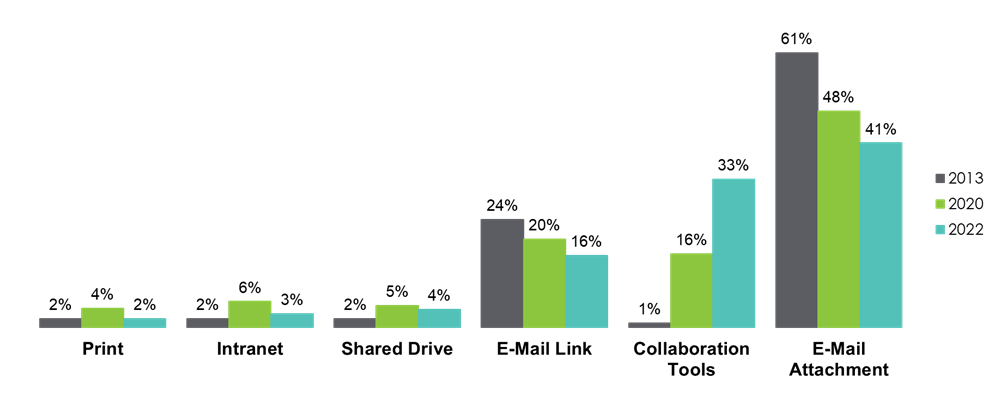CCC has licensed this analysis from Outsell, Inc. with the right to distribute it for marketing and market education purposes. CCC commissioned the research study from Outsell and had no input regarding the content of this piece. Outsell’s fact-based analysis and all aspects of our opinion were independently derived. For questions, please contact Outsell.
Why This Market
Outsell’s latest Information Consumption Study reveals dramatic post-pandemic changes. The number one difference? Collaboration tools have nearly displaced email as the top method of sharing information. This analysis explores findings from our eighth study and analyzes the impact and implications.
Methodology
In a study on behalf of CCC Outsell surveyed 630 professionals evenly split across 14 industries. Respondents were based in one of 10 countries—US, UK, Germany, Netherlands, Austria, Denmark, Switzerland, Japan, India, and Korea—and worked full-time in companies with 1,000 or more employees. They were also from a mix of roles; 29% were executives, 49% were middle managers, and 22% were individual contributors. The research updated a series of surveys we have conducted for CCC since 2003 that track what professionals think and how they behave around content and information.
Key Findings
Understanding the nature of information consumption is a core need for any provider across our industry, and this study highlights three important changes in an emerging post-pandemic work environment. Each of these has important implications for serving market needs.
Remote Work Impacted the Rate of Content’s Flow
The pandemic drove changes in where and how we work. Professions once tethered to an office desk saw the boundaries broken and an increased level of remote work. To better understand how that impacts content flow, we asked respondents to choose from a picklist of options regarding the impact of remote work on their content-sharing habits. As shown in Figure 1, the data indicates workers are sharing more often, and when they do, they’re sharing with more people. The most dramatic increase is found among executives.

The results are not surprising. As the pandemic forced nearly everyone (at least temporarily) into remote work environments, digital replaced physical for all interactions. Gaps in communication emerged and the data shows users overcompensated. The net result: attention spans that were already under strain are facing greater assault. For data and information providers, that means even greater challenges in getting output noticed and heard. It also means nearly unfettered sharing.
Collaboration Tools Rapidly Gained Ground
To understand how content is shared among professionals, we asked respondents to indicate their preferred sharing method. While email still retains the number one spot, it has lost considerable ground to collaboration tools. And at the current rate of change, email will cede its spot as the killer app by the end of this year. Two-thirds of respondents indicate using collaboration tools to share information (Figure 2), and one-third (33%) prefer this method over all others.

This change has important implications for data and information providers. Workers are sharing content with a greater number of colleagues, and one likely reason is that collaboration tools allow sharing without creating a heavy burden on the recipient.
Individuals can opt in or out from a communication more easily than when delivered via an email that hits the inbox. That creates further challenges in gaining reader attention. Said another way, content is easier to ignore on collaboration tools. Yet there is also a stickiness to collaboration tools that doesn’t exist with email. Content distributed on these new tools may persist for years. Since these tools are clearly here to stay, providers need to consider the implications these tools have on content licensing and display.
Challenges with Information Sharing Are on the Rise
Survey respondents answered a series of questions posed to better understand their copyright awareness and compliance. Their responses, which are detailed in Figure 3, collectively point to potential challenges that crop up as new ways of sharing emerge. First, we asked if individuals take responsibility for verifying permission before sharing outside content. In comparison to 2016, there has been a dramatic and positive increase; four out of five (80%) of respondents indicate they take responsibility.
That is where the good news ends. When asked if they would share any and all information in mission-critical moments, nearly three-fourths (72%) said they would. That’s a dramatic increase over 2016. This indicates that while copyright awareness is growing and strong, at times there is likely a gap in compliance. And the reasons for that gap? It has gotten harder to obtain permission. Nearly two-thirds (62%) of respondents stated they face sharing obstacles because obtaining permission is challenging. One reason? Collaboration tools create new demands.

Outsell calculates an information sharing metric that we term the “velocity of content.” By taking the average number of times information is shared each week and multiplying it by the average number of people the information is shared with, we determine the average number of shares overall. We then reduce this by multiplying the result by the percentage of shared information that is external third-party content. The result: the potential for violations per employee in an organization. In comparing 2022 to 2016, we see a dramatic increase. The velocity of content averaged 56.9 violations in 2022, up from a more reasonable—though still challenging—17.8 violations in 2016.
Implications
Changes in work environments brought about by the pandemic—especially the accelerated adoption of collaboration tools—is impacting how content is consumed and shared. All professionals are sharing content more frequently and with more colleagues, yet they’re finding it more difficult to obtain proper permission to do so. Content providers need to keep up with these changes by modernizing their licensing policies while also considering the impact on searchability and display.
Collaboration tools center around working together to produce a common output, and often this includes content at the center of the effort. Yet static PDFs aren’t well designed for these environments as excerpts aren’t easily created and/or marked up. Those providers that enable easier extraction of content while providing terms and tools for respecting licenses will likely find greater adoption and stickiness among customers and end-users.
Essential Actions
As the use of collaboration tools changes the way we interact with content in our working lives, information providers must take the following steps to ensure maximum reach:
Embrace Collaboration Tools as the New Workflow
While the build-out and adoption of workflow tools is not a new trend, collaboration tools are becoming the core of the new workflow, and that gives us an opportunity to embrace them. Understand how these tools change interaction and consider how this impacts the ways individuals will interact with content.
Enable Atomization of Content
While providers like to think their content is best consumed in its entirety, the pressures on today’s workforce make that type of complete consumption unlikely. While not a new trend, it is being accelerated by collaboration tools. Providers are advised to deliver their content in a way that facilitates, rather than hinders, fragmentation. Doing so means ensuring that proper attribution follows these snippets. Many tools already provide this, and their adoption needs to become de facto standard.
Prepare for New Formats
Collaboration tools tend to be more visual in nature. With TikTok’s rise and content’s reduction to 140-character threads, there is a need and an opportunity to transition to new formats. Pictures, videos, and podcasts are all essential mediums today, and the upside is that many lend themselves well to collaboration tools. Providers are encouraged to be sure they’re giving thought to how these formats fit in their value proposition.
Revisit Licensing Terms
Acknowledging new habits of information sharing and adopting license terms that reflect them will go a long way in building goodwill amongst your customers. As respondents indicated, they will share your content regardless of permission if it is deemed mission critical. Help them stay compliant by ensuring licensing terms reflect these tools’ use.
Copyright 2023 Outsell, Inc


